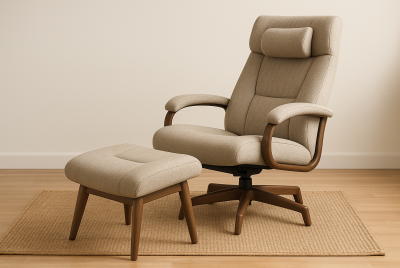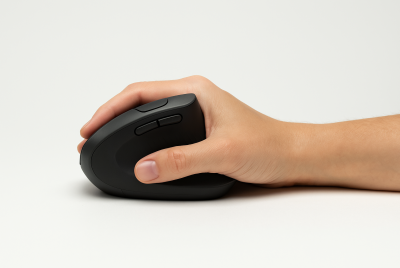How To Make Your Outdoor Workstation Ergonomic This Summer
We may earn a commission for purchases made using our links. Please see our disclosure to learn more.
When the weather warms up, working from home does not have to mean staying inside. Creating an ergonomic outdoor workstation is not only doable; it may have a significant impact on productivity, comfort, and overall well-being. However, working outside presents distinct problems, particularly if you want to prevent back pain, eye strain, and lunchtime energy dips. Ready to create a setup that actually works for you? Here’s a step-by-step guide to creating a dream ergonomic outdoor workspace this summer.
Why Set Up an Outdoor Workstation?
Working with a cool breeze, warm sunlight, and birdsong in the background has a certain allure. Most employees long for a change of scenery, and research suggests that being in nature can increase creativity, lower stress levels, and even sharpen attention.
However, not every outdoor configuration is the same. A misplaced table and chair will soon cause discomfort, diversions, and annoyance. Any patio, balcony, or backyard can be turned into a productive environment that promotes your hustle and your health by following a few simple steps.
Ergonomics 101: The Basics You Need Outside
Ergonomics is more than simply a fancy terminology. It’s about making your workspace align with your body, not the other way around. Indoors, this means having adjustable chairs and screens at eye level. Outside, consider surface height, glare, temperature, and the unpredictability of nature.
Key ergonomic principles for outdoors:
- Neutral posture: Keep your spine aligned and your arms, wrists, and legs relaxed.
- Screen at eye level: Prevent neck strain and headaches by raising your laptop or monitor.
- Proper support: Choose seating with good lumbar support, or add a cushion if needed.
- Movement: Stand, stretch, and shift positions regularly.
- Light management: Shield your eyes from direct sunlight, but aim for bright, even lighting.

Step-By-Step Guide to Creating an Ergonomic Outdoor Workstation
1. Pick the Right Spot
Start with location. Find a space with shade, stable ground, and minimal distractions. A covered patio, shady tree, or balcony with a sun umbrella all work well. Avoid areas with strong wind or direct midday sun—you don’t want to bake or have your paperwork flying around!
2. Choose a Comfortable Chair
Skip the flimsy folding chair. Look for an outdoor chair with real back support. If you have an ergonomic office chair that’s weatherproof, bring it outside! Otherwise, invest in a quality patio chair and add a lumbar pillow or seat cushion for extra comfort.
3. Optimize Your Table or Desk Height
An ideal work surface lets your arms rest at a 90-degree angle while typing. If your table is too low or too high, use risers or a portable laptop stand. Stable, wobble-free tables are essential for focus and wrist comfort.
4. Master Your Monitor Setup
Don’t hunch over your laptop! Use a laptop riser or stack of sturdy books to raise the screen to eye level. Pair with an external keyboard and mouse for proper alignment. If glare is an issue, try a matte screen protector or position your screen away from direct sunlight.
5. Accessorize for Comfort and Efficiency
Small touches can make a huge difference. Consider a portable footrest, anti-fatigue mat if you stand, and a mouse pad with wrist support. Stay hydrated by keeping a water bottle nearby, and use wireless headphones to block out noise.
6. Manage Sunlight and Weather
Working outdoors means battling the elements. Invest in a large umbrella, awning, or pop-up tent for adjustable shade. Wear sunglasses to reduce glare, and use a portable fan or cooling towel on hot days. Also, keep bug repellent and sunblock on hand!
If you love the idea of combining work and relaxation, consider exploring the Best Ergonomic Recliner as a way to bring that ultimate level of support to your home office—indoors or out.
Recommended Products for Your Outdoor Workstation
Level up your ergonomic outdoor workstation with these highly-rated essentials:
- Keter Urban Knit Pouf Ottoman Set: Versatile, stylish seating that doubles as a table or footrest.
- GCI Outdoor Freestyle Rocker Chair: Comfortable, portable rocker with lumbar support for all-day seating.
- Cooper Desk Laptop Riser: Lightweight, adjustable stand to raise your laptop or monitor.
- Logitech K780 Multi-Device Wireless Keyboard: Type comfortably across devices; perfect for tablet or laptop setups.
- Anker Ergonomic Wireless Mouse: Reduce wrist strain with a comfortable, responsive mouse.
- Sport-Brella Versa-Brella Adjustable Umbrella: Clip-on shade for ultimate sun protection, wherever you sit.
- ThermoFlask Double Stainless Steel Water Bottle: Stay hydrated with ice-cold drinks, even on the hottest days.
- ComfiLife Gel Enhanced Seat Cushion: Instantly upgrade any chair for better posture and less fatigue.
Note: Always check product reviews and ensure each item fits your specific needs and outdoor space!

Expert Advice and Research: Why Ergonomics Matter
Wondering if investing in an ergonomic outdoor workstation is worth the effort? The science says yes—big time. Recent research shows that adjusting your workspace to support your body isn’t just a matter of comfort; it’s essential for long-term health and productivity.
A major systematic review on ergonomic chair interventions found that adding adjustable features, like seat height and depth, immediately reduced musculoskeletal pain among office workers. In other words, the right chair isn’t just a nice-to-have—it actively helps prevent aches and pains, even if you’re only outside for a few hours a day.
But it doesn’t stop there. According to a large-scale meta-analysis of ergonomic interventions, proper ergonomic changes—like using an adjustable desk, supportive chair, and correct screen placement—significantly reduced overall pain for workers and cut the odds of lower-back pain almost in half. These benefits also extended to the neck, wrists, and even ankles. It’s clear that a few simple tweaks can make a massive difference.
And it’s not just researchers who agree. The Occupational Safety and Health Administration (OSHA) strongly recommends following ergonomic best practices at any workstation, including outdoor setups. OSHA emphasizes maintaining neutral posture, aligning your screen at eye level, and regularly changing positions to avoid repetitive strain and fatigue.
So if you’re serious about making your summer workdays both productive and pain-free, trust the research: ergonomic upgrades are more than worth it.
Conclusion
Summer is the perfect time to rethink your workspace and embrace the fresh air. With a little planning, the right ergonomic products, and a focus on comfort, your outdoor workstation can rival any indoor office. Don’t wait until your neck aches or laptop overheats—take control of your setup, enjoy the outdoors, and make every workday a little brighter.
Ready to transform your outdoor work experience? Start small, experiment with your setup, and listen to your body’s feedback. Your productivity—and your back—will thank you.
FAQs
1. What’s the most important element of an ergonomic outdoor workstation?
The most crucial element is proper seating and screen height alignment. Both prevent strain and keep you comfortable through long work sessions.
2. Can I use my regular office chair outside?
If it’s weatherproof and on a stable surface, yes! Otherwise, use a quality outdoor chair with added support, and bring cushions back inside after use.
3. How do I avoid glare on my screen outside?
Use a matte screen protector, position your screen away from direct sunlight, and work in shaded areas for best results.
4. What should I do if I don’t have a patio or backyard?
Balconies, rooftop terraces, or even a shady spot in a local park can become effective workstations with the right portable gear.
5. Are there health risks to working outdoors?
Not if you plan properly. Protect yourself from sun exposure, stay hydrated, and follow ergonomic principles to prevent injury and discomfort.




